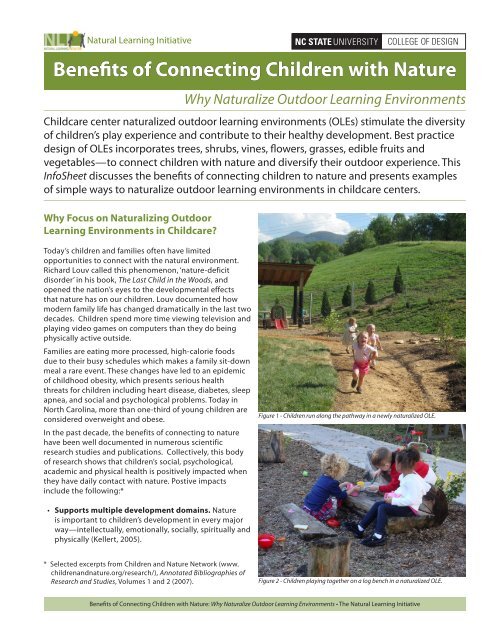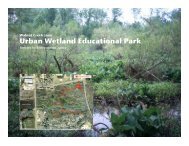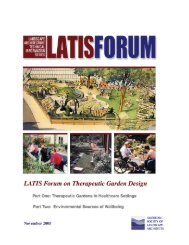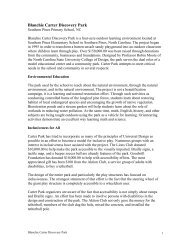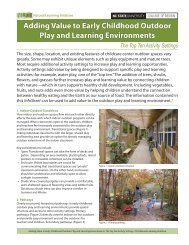Benefits of Connecting Children with Nature - Natural Learning ...
Benefits of Connecting Children with Nature - Natural Learning ...
Benefits of Connecting Children with Nature - Natural Learning ...
Create successful ePaper yourself
Turn your PDF publications into a flip-book with our unique Google optimized e-Paper software.
<strong>Natural</strong> <strong>Learning</strong> Initiative NC STATE UNIVERSITY COLLEGE OF DESIGN<br />
<strong>Benefits</strong> <strong>of</strong> <strong>Connecting</strong> <strong>Children</strong> <strong>with</strong> <strong>Nature</strong><br />
Why <strong>Natural</strong>ize Outdoor <strong>Learning</strong> Environments<br />
Childcare center naturalized outdoor learning environments (OLEs) stimulate the diversity<br />
<strong>of</strong> children’s play experience and contribute to their healthy development. Best practice<br />
design <strong>of</strong> OLEs incorporates trees, shrubs, vines, flowers, grasses, edible fruits and<br />
vegetables—to connect children <strong>with</strong> nature and diversify their outdoor experience. This<br />
InfoSheet discusses the benefits <strong>of</strong> connecting children to nature and presents examples<br />
<strong>of</strong> simple ways to naturalize outdoor learning environments in childcare centers.<br />
Why Focus on <strong>Natural</strong>izing Outdoor<br />
<strong>Learning</strong> Environments in Childcare?<br />
Today’s children and families <strong>of</strong>ten have limited<br />
opportunities to connect <strong>with</strong> the natural environment.<br />
Richard Louv called this phenomenon, ‘nature-deficit<br />
disorder’ in his book, The Last Child in the Woods, and<br />
opened the nation’s eyes to the developmental effects<br />
that nature has on our children. Louv documented how<br />
modern family life has changed dramatically in the last two<br />
decades. <strong>Children</strong> spend more time viewing television and<br />
playing video games on computers than they do being<br />
physically active outside.<br />
Families are eating more processed, high-calorie foods<br />
due to their busy schedules which makes a family sit-down<br />
meal a rare event. These changes have led to an epidemic<br />
<strong>of</strong> childhood obesity, which presents serious health<br />
threats for children including heart disease, diabetes, sleep<br />
apnea, and social and psychological problems. Today in<br />
North Carolina, more than one-third <strong>of</strong> young children are<br />
considered overweight and obese.<br />
In the past decade, the benefits <strong>of</strong> connecting to nature<br />
have been well documented in numerous scientific<br />
research studies and publications. Collectively, this body<br />
<strong>of</strong> research shows that children’s social, psychological,<br />
academic and physical health is positively impacted when<br />
they have daily contact <strong>with</strong> nature. Postive impacts<br />
include the following:*<br />
• Supports multiple development domains. <strong>Nature</strong><br />
is important to children’s development in every major<br />
way—intellectually, emotionally, socially, spiritually and<br />
physically (Kellert, 2005).<br />
* Selected excerpts from <strong>Children</strong> and <strong>Nature</strong> Network (www.<br />
childrenandnature.org/research/), Annotated Bibliographies <strong>of</strong><br />
Research and Studies, Volumes 1 and 2 (2007).<br />
Figure 1 - <strong>Children</strong> run along the pathway in a newly naturalized OLE.<br />
Figure 2 - <strong>Children</strong> playing together on a log bench in a naturalized OLE.<br />
<strong>Benefits</strong> <strong>of</strong> <strong>Connecting</strong> <strong>Children</strong> <strong>with</strong> <strong>Nature</strong>: Why <strong>Natural</strong>ize Outdoor <strong>Learning</strong> Environments • The <strong>Natural</strong> <strong>Learning</strong> Initiative
Figure 3 - Primary pathways encourage vigorous physical activity.<br />
• Supports creativity and problem solving. Studies<br />
<strong>of</strong> children in schoolyards found that children engage<br />
in more creative forms <strong>of</strong> play in the green areas. They<br />
also played more cooperatively (Bell and Dyment,<br />
2006). Play in nature is especially important for<br />
developing capacities for creativity, problem-solving,<br />
and intellectual development (Kellert, 2005).<br />
• Enhances cognitive abilities. Proximity to, views<br />
<strong>of</strong>, and daily exposure to natural settings increases<br />
children’s ability to focus and enhances cognitive<br />
abilities (Wells, 2000).<br />
• Improves academic performance. Studies in the US<br />
show that schools that use outdoor classrooms and<br />
other forms <strong>of</strong> nature-based experiential education<br />
support significant student gains in social studies,<br />
science, language arts, and math. Students in outdoor<br />
science programs improved their science testing scores<br />
by 27% (American Institutes for Research, 2005).<br />
• Reduces Attention Deficit Disorder (ADD) symptoms.<br />
Contact <strong>with</strong> the natural world can significantly reduce<br />
symptoms <strong>of</strong> attention deficit disorder in children as<br />
young as five years old (Kuo and Taylor, 2004).<br />
• Increases physical activity. <strong>Children</strong> who experience<br />
school grounds <strong>with</strong> diverse natural settings are more<br />
physically active, more aware <strong>of</strong> nutrition, more civil to<br />
one another and more creative (Bell and Dyment, 2006).<br />
Figure 4 - This secondary pathway encourages active exploration and discovery.<br />
Figure 5 - This moderate-sized grassy lawn facilitates active group games.<br />
• Improves nutrition. <strong>Children</strong> who grow their own<br />
food are more likely to eat fruits and vegetables (Bell &<br />
Dyment, 2008) and to show higher levels <strong>of</strong> knowledge<br />
about nutrition (Waliczek, & Zajicek, 2006). They are<br />
also more likely to continue healthy eating habits<br />
throughout their lives (Morris & Zidenberg-Cherr, 2002).<br />
• Improves eyesight. More time spent outdoors is<br />
related to reduced rates <strong>of</strong> nearsightedness, also known<br />
as myopia, in children and adolescents (American<br />
Academy <strong>of</strong> Ophthalmology, 2011).<br />
• Improves social relations. <strong>Children</strong> will be smarter,<br />
better able to get along <strong>with</strong> others, healthier and<br />
happier when they have regular opportunities for free<br />
and unstructured play in the out-<strong>of</strong>-doors (Burdette and<br />
Whitaker, 2005).<br />
• Improves self-discipline. Access to green spaces, and<br />
even a view <strong>of</strong> green settings, enhances peace, selfcontrol<br />
and self-discipline <strong>with</strong>in inner city youth, and<br />
particularly in girls (Taylor, Kuo and Sullivan, 2001).<br />
• Reduces stress. Green plants and vistas reduce stress<br />
among highly stressed children. Locations <strong>with</strong> greater<br />
number <strong>of</strong> plants, greener views, and access to natural<br />
play areas show more significant results (Wells and<br />
Evans, 2003).<br />
<strong>Benefits</strong> <strong>of</strong> <strong>Connecting</strong> <strong>Children</strong> <strong>with</strong> <strong>Nature</strong>: Why <strong>Natural</strong>ize Outdoor <strong>Learning</strong> Environments • The <strong>Natural</strong> <strong>Learning</strong> Initiative
Figure 6 - Before the renovation, this OLE consisted mostly <strong>of</strong> patchy lawn and manufactured play equipment.<br />
Figure 7 - After the outdoor learning environment was renovated and naturalized; it includes raised garden beds, a looped pathway, arbor, and many new trees.<br />
<strong>Children</strong> Need “Vitamin G”<br />
“Green environments are an essential component <strong>of</strong> a<br />
healthy human habitat” according to Frances Ming Kuo,<br />
a researcher documenting the positive link between<br />
nature and human health, and social and psychological<br />
functioning. Kou summarizes various research studies<br />
that show that humans benefit from exposure to green<br />
environments (parks, forests, gardens, etc.) and conversely,<br />
people <strong>with</strong> less access to green places report more<br />
medical symptoms and poorer health overall. Kuo uses<br />
the phrase “Vitamin G” (G for “green”) to capture nature’s<br />
role as a necessary ingredient for a healthy life. Evidence<br />
suggests that, like a vitamin, contact <strong>with</strong> nature and<br />
green environments is needed in frequent, regular doses.<br />
<strong>Natural</strong>izing Outdoor <strong>Learning</strong> Environments in<br />
Childcare<br />
The majority <strong>of</strong> children are in childcare for extended<br />
periods <strong>of</strong> time, <strong>of</strong>ten eight to ten hours per day, which<br />
makes greening their environment by adding natural<br />
elements vital to their overall health and functioning.<br />
<strong>Natural</strong>izing outdoor learning environments means<br />
bringing back trees, shrubs, perennial plants, vines,<br />
and edible plants for children’s enjoyment and healthy<br />
development (Figures 9-14). Childcare centers <strong>with</strong><br />
naturalized outdoor environments allow children to have<br />
safe, ready-made access to green places and engagement<br />
<strong>with</strong> nature. A diverse array <strong>of</strong> plant life encourages<br />
children to experience nature in more ways and more<br />
frequently.<br />
Childcare centers across North Carolina are naturalizing<br />
their outdoor learning environments. For example, the<br />
childcare center above made significant improvements to<br />
their OLE (Figures 6 and 7). The center added a welcoming<br />
arbor (Figure 7) at the entrance to the outdoor learning<br />
environment <strong>with</strong> planters for flowers and vegetables<br />
(Figure 8), a defined lawn area, trees for shade, and a fine<br />
crushed stone pathway to increase physical activity and<br />
improve circulation.<br />
Figure 8 - Teacher and child plant rainbow chard in a raised garden planter.<br />
<strong>Benefits</strong> <strong>of</strong> <strong>Connecting</strong> <strong>Children</strong> <strong>with</strong> <strong>Nature</strong>: Why <strong>Natural</strong>ize Outdoor <strong>Learning</strong> Environments • The <strong>Natural</strong> <strong>Learning</strong> Initiative
Figure 9 - Fence naturalized <strong>with</strong> edible vines.<br />
Figure 10 - <strong>Children</strong> explore a small tree.<br />
<strong>Benefits</strong> <strong>of</strong> <strong>Connecting</strong> <strong>Children</strong> <strong>with</strong> <strong>Nature</strong>: Why <strong>Natural</strong>ize Outdoor <strong>Learning</strong> Environments January 2012<br />
Creating a Supportive Network and Training Resources for <strong>Natural</strong>ized <strong>Learning</strong> Environments in Child Care<br />
Supported by: North Carolina Division <strong>of</strong> Child Development and Early Education<br />
<strong>Natural</strong> <strong>Learning</strong> Initiative | College <strong>of</strong> Design | North Carolina State University<br />
Creating environments for healthy human development and a healthy biosphere for generations to come.<br />
The purpose <strong>of</strong> the <strong>Natural</strong> <strong>Learning</strong> Initiative is to promote the importance <strong>of</strong> the natural environment in the daily<br />
experience <strong>of</strong> all children, through environmental design, action research, education, and dissemination <strong>of</strong> information.<br />
www.naturalearning.org<br />
919-515-8345<br />
Figure 13 - xxx.<br />
Figure 11 - Raised garden bed <strong>with</strong> vegetables, flowers, and herbs.<br />
Figure 12 - <strong>Children</strong> playing <strong>with</strong> natural loose parts under the canopy <strong>of</strong> a small ornamental grass.<br />
Figure 13 - Tree cookies are versatile loose parts.<br />
Figure 14 - Smooth, moveable stones as loose parts.<br />
Disclaimer: The material contained in this InfoSheet was produced by the<br />
<strong>Natural</strong> <strong>Learning</strong> Initiative (NLI) for informational purposes only. InfoSheets<br />
are not intended to guide construction or installation <strong>of</strong> items. In no event<br />
will NLI be liable for any loss or damage (including <strong>with</strong>out limitation, indirect<br />
or consequential loss or damage) from the use <strong>of</strong> or reliance on this material.<br />
<strong>Benefits</strong> <strong>of</strong> <strong>Connecting</strong> <strong>Children</strong> <strong>with</strong> <strong>Nature</strong>: Why <strong>Natural</strong>ize Outdoor <strong>Learning</strong> Environments • The <strong>Natural</strong> <strong>Learning</strong> Initiative


